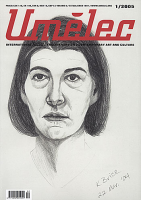| Zeitschrift Umělec 2005/1 >> Women-Network: Mária Rišková "Spidergirl from Bratislava" | Übersicht aller Ausgaben | ||||||||||||
|
|||||||||||||
Women-Network: Mária Rišková "Spidergirl from Bratislava"Zeitschrift Umělec 2005/101.01.2005 Denisa Kera | profil | en cs |
|||||||||||||
|
In a book from 1997 that has already become legendary, Zeros and Ones: Digital Women and the New Techno-culture, Sadie Plant argues for an affinity between women and digital technologies. The affinity stems from the notion that women and computers ostensibly lack identity and essence. The computer as a machine only simulates the work of other machines and we define it according to what it does now, not according to what it is. Similarly, women were for a long time said to lack a soul or some other centralized “part,” that would define their identity. Women and present day technology have such things in common as “multitasking,” the ability to do and be more things at once, or an image of the world as a network of meanings and relations which exist only in processes. We could almost say that what computer networks and technologies are learning today, women have known for thousands of years.
When I met Mária Rišková I started for the first time to understand digital technologies as a radically “female media.” How else could one explain the amount of activities and identities that are hidden in this always smiling and calm person other than as a “mysterious” affinity between women and new technologies? The director of the well-known cultural space Buryzone which created interest in new media and art in Bratislava and spread and transformed into the form of the present day Burundi media lab and alternative cultural space; the main coordinator of the annual international festival of new media and culture in Bratislava, Multiplace, a long-time curator of the exhibition of graphic design in Trnava, a founding member of the group of women - curators and theoreticians NADA (New Approaches to the Domain of Art), and more; to name all the activities of this art historian, curator, organizer, not to mention her publishing and lecturing activities, would require a whole database. It is as difficult to define Mária Rišková as it is to explain the phenomena of present day technologies. Mária and computers—both are omnipresent and create new and wider “networks”. While in the Czech Republic discussion about the financing of alternative culture has started only recently, talks in the field of digital culture and contemporary art between Slovaks and the rest of the world have been going on for years. One of the reasons is the existence of organizations like the one which Mária Rišková founded or helped to found with many enthusiasts outside official structures. So it is not uncommon that when you say Burundi or Buryzone, people know immediately where you are from, whereas when talking about Prague people politely ask whether they haven’t missed something, or whether nothing really is happening on the Czech scene. All Mária Rišková’s activities confirm Sadie Plant’s idea that digital technologies and women both function with no centralized or solid structure, and therefore show that things can work successfully outside the “patriarchal” and hierarchic order. As a mastermind of the young culture joined with digital technologies, Mária Rišková works independently of national galleries, art schools and other state organizations that have contemporary art embedded in the “job description.” She acts in step with the credo articulated in one of her interviews: “If you don’t like the existing conditions, create your own space.” This sentence should serve as a slogan for contemporary digital culture and art as it searches with considerable difficulty for the correct platform and institutional support. Mária Rišková’s activities illustrate one of the axioms of digital culture: small causes create complex phenomena—like the phenomena of successful Slovak culture and art over the last decade. We can find it everywhere where there is something interesting going on. The newest project is “Dial 44,” an art and cultural exchange between Slovak and British artists under the patronage of the British Council. The non-profit activities in the field of art in Slovakia make a successful model for the support of contemporary young culture and work of a new type of art organizations. But most of all it is an emphasis on the networks and non-linear, associative and emerging structures. A successful example is A4, a zero space in the center of Bratislava. This space brought together organizations and people interested in contemporary art, dance, music, film and architecture, in the framework of Burundi. Mária Rišková is a woman-network that can interconnect people, interests and entire organizations into functioning units and, in doing so, create whole cultural “ecologies.” She is not unlike a character in a popular film: she is a “Spidergirl from Bratislava,” who spins a web whose threads tie Slovakia with the rest world.
01.01.2005
Empfohlene Artikel
|
|||||||||||||









Kommentar
Der Artikel ist bisher nicht kommentiert wordenNeuen Kommentar einfügen